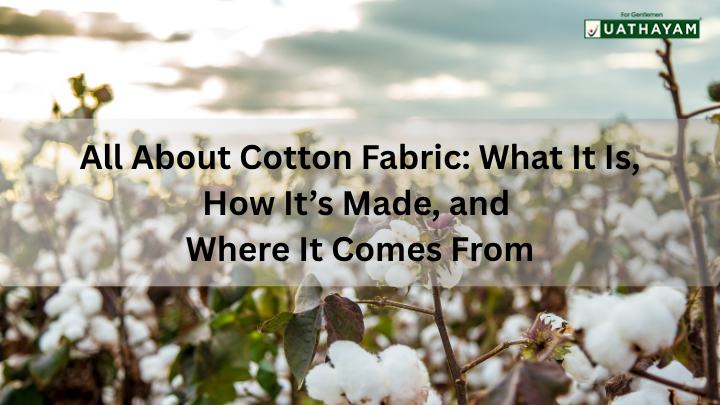All About Linen Fabric: What It Is, How It’s Made, and Where It Comes From
Linen fabric is like summer in a cloth light, breezy, and effortlessly cool. You’ve probably seen it in flowy shirts, crisp tablecloths, or those perfect pants for a beach getaway. But what makes linen so special? How does it go from a plant in a field to your favourite outfit? And where does it come from? Let’s break it down in clear, simple terms to show why linen is such a big deal.
What Is Linen Fabric?
Linen is a natural fabric made from the fibers of the flax plant, a tall, slender crop grown in cooler climates. Those fibers are spun into threads and woven into the fabric we call linen, which has been around for thousands of years. Ancient Egyptians even used it to wrap mummies! People love linen for its airy feel, natural texture, and ability to make you look polished without trying too hard.
Why’s linen such a hit? It’s super breathable, keeping you cool even when the sun’s blazing. It’s also strong, lasting through years of wear if you care for it right. Plus, it has a unique, slightly textured look that screams relaxed sophistication, whether it’s a loose shirt or a fancy table runner.
Properties of Linen Fabric
Linen has some awesome qualities that make it a go-to for clothes, bedding, and home decor. Here’s the rundown:
-
Breathable and Cool: Linen lets air flow freely, making it perfect for hot days. It wicks away sweat, so you stay fresh.
-
Strong and Durable: Linen is one of the toughest natural fibers out there. It can handle lots of washes and still look great.
-
Textured and Stylish: Its slightly rough, natural weave gives it a casual yet classy vibe. The more you wear it, the softer it gets.
-
Absorbent: Linen soaks up moisture fast, which is why it’s great for towels or napkins. It dries quickly, too.
-
Eco-Friendly: Flax plants need less water and pesticides than some crops, making linen a greener choice.
-
Hypoallergenic: It’s gentle on sensitive skin, so it’s a solid pick for anyone prone to irritation.
On the downside, linen wrinkles like nobody’s business. Those creases are part of its charm, but they can annoy you if you want a super crisp look. It’s also not as stretchy as synthetic fabrics, so it might feel a bit stiff at first. But give it time, and it molds to you like a friend.
How Is Linen Fabric Made?
Turning flax into linen is a labour of love that takes skill and patience. Here’s how it happens, step by step:
-
Growing and Harvesting: Flax plants grow in cooler regions like parts of Europe or Canada. After about 100 days, when the plants turn golden and the seeds ripen, they’re pulled from the ground, roots and all, to keep the fibers long.
-
Retting: The stalks are left to soak in water or dew, or sometimes treated with chemicals, to break down the outer layer and free the fibers inside. This process, called retting, can take a few weeks and is key to getting usable fibers.
-
Scutching and Hackling: Once retted, the stalks are dried and crushed to separate the fibers. This is called scutching. Then, they’re combed, or hackled, to remove short bits and align the long fibers, making them smooth and ready for spinning.
-
Spinning: The fibers are twisted into yarns. This can be done by hand in traditional methods or with machines for mass production. The yarn’s thickness decides whether the linen will be fine, like for shirts, or coarse, like for upholstery.
-
Weaving: The yarns are woven into fabric, usually in a plain or loose weave to keep that airy feel. Linen’s natural texture comes from the uneven thickness of flax fibers, giving it that signature look.
-
Finishing: The raw fabric is washed, bleached, or dyed to get the desired colour and softness. Some linen is stone-washed for extra softness or treated to reduce wrinkling.
-
Cutting and Sewing: Finally, the fabric is cut and stitched into shirts, dresses, bedding, or whatever else it’s meant for. Quality checks ensure it’s ready for your closet or home.
This process is slow and careful, which is why linen feels so special. It’s like the fabric carries the care of everyone who touched it.
Where Does Linen Come From?
Flax for linen grows best in cooler, temperate climates, and a few places lead the way in production. Here’s where most linen comes from:
-
Belgium and France: These countries, especially the Flanders region, are known for top-quality linen. The cool, damp climate is perfect for flax, and their linen is often used for luxury goods.
-
China: A major player, China produces a ton of linen, often at lower costs. It’s a go-to for affordable linen clothing and home goods.
-
Ireland: Famous for its fine linen, Ireland has a long history of producing high-quality fabric, especially for tablecloths and napkins.
-
Eastern Europe: Countries like Russia, Ukraine, and Belarus grow flax for both local use and export. Their linen is often sturdy and versatile.
-
Egypt and Italy: These places produce smaller amounts of premium linen, often for high-end fashion or bedding.
The quality of linen depends on the flax and how it’s processed. Belgian linen, for example, is prized for its long fibers and smooth weave, while Chinese linen is more budget-friendly but still reliable. Some brands certify their linen to guarantee its origin, like “European Flax” for eco-conscious buyers.
Why Linen Matters
Linen is more than just fabric, it’s a lifestyle choice. It’s sustainable, since flax needs less water and chemicals than cotton. It’s also biodegradable, so it won’t clog up landfills like synthetic fabrics. Plus, linen gets better with age. Those wrinkles tell a story of wear and love, not neglect.
Linen supports farmers and artisans, especially in regions like Europe where flax has been grown for centuries. It’s also a favourite for eco-conscious folks who want natural, long-lasting materials. From breezy summer dresses to durable curtains, linen fits into every corner of life with style and purpose.
Tips for Caring for Linen
Want your linen to stay awesome? Here’s how to keep it looking fresh:
-
Wash Gently: Use cold or warm water with mild detergent to keep colours bright and fibers strong. Avoid harsh chemicals.
-
Dry Smart: Air dry to preserve the fabric’s texture, or tumble dry on low. Overheating can make linen brittle.
-
Embrace Wrinkles: Linen’s creases are part of its charm, but if you must iron, do it while the fabric’s slightly damp.
-
Store Carefully: Keep linen in a cool, dry place to avoid mildew, since it loves to soak up moisture.
-
Check Labels: Some linen blends need special care, so always read the tag.
Conclusion
Linen fabric is a superstar for its cool, breathable feel and timeless style. From the flax fields of Belgium to the looms that weave it into your favourite shirt, it’s a journey of craft and care. Whether you’re rocking a linen blazer at a wedding or tossing a linen throw on your couch, you’re part of a story that’s been unfolding for centuries. Next time you slip into something linen, you’ll know why it feels so good and where it came from.






